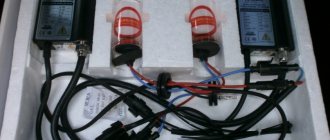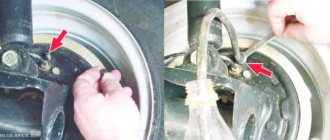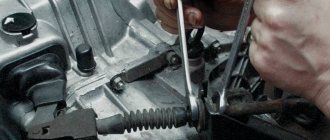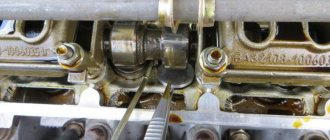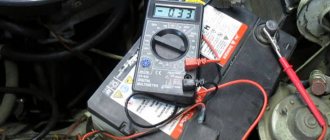How to properly remove the battery from a car: do-it-yourself dismantling, sequence of actions and safety measures During the operation of the car, each owner has to carefully monitor the battery and its charge. While professional mechanics have perfect knowledge of how to properly remove the battery from a car, this may raise a lot of questions for others. The matter is simple, but first you will need to familiarize yourself with the basics so as not to damage the electrical wiring of the machine during manipulation.
Causes and consequences
A car SLI battery supplies electricity to the vehicle. It is necessary for lighting, ignition, powering electrical appliances and starting the engine.
Batteries require regular maintenance.
To keep the battery in working condition, you should protect it from the cold, regularly clean the contacts from carbonate and deposits, and check the electrolyte level. There are many reasons why it needs to be removed. Among the common ones are:
- emergency charging;
- removal for storage during a long period of non-use of the vehicle;
- battery maintenance;
- replacing batteries or other car and engine parts.
Even if you have a maintenance-free battery and do not need to regularly add distilled water, measure electrolyte levels, etc., you will still have to remove the battery often. For example, for winter storage or emergency charging.
Removing the battery is a simple operation, but before doing it, it is recommended that you familiarize yourself with the instructions and mechanics of the power controller in a specific car brand.
In particular, expensive luxury foreign cars, such as Volvo XC70, Infinity, Lexus, Peugeot, are often equipped with several electronic control units responsible for various functions. The settings of additional power controllers can be reset when the battery is removed, so it is recommended to carry out servicing of such cars at the stations of an official dealer.
In most cases, this is still an easy matter. From cars such as Lada, Matiz, MAZ, Kia Rio, Priora, Chevrolet, and from 80% of other cars, the battery can be easily removed, since the cars have only one battery (we are not talking about the battery, but about something else?) with standard settings that are not reset.
Mid-segment cars, for example, Volkswagen, Hyundai Solaris, Renault Logan, Honda, are often also equipped with special toggle switches that turn off the power system and simplify battery removal.
Summarizing
The information presented in the article will allow anyone, even a novice driver, to safely replace the battery, subject to all regulatory requirements for the procedure and the correct approach to performing the task.
If your car belongs to the category of elite class transport, is equipped with “complex” modern “brains”, then it is better to refrain from replacing the battery yourself, entrusting the work to specialists from car service stations, or, when the car is under warranty, contact an official service representative. Such a precaution will avoid the risk of “breakage” of the on-board computer, the cost of repairing which is far from being considered budgetary waste.
Preparing for work
Before dismantling the battery, you should acquire knowledge and prepare the necessary tools.
Carrying out careless work can result in battery damage or failure of other vehicle systems.
Any work with the battery should be carried out with rubber gloves. If the hermetic integrity of the structure is violated, this will prevent electrolyte from getting on the skin.
Flammable anti-corrosion substances and the electrical charge present in the battery are also dangerous. So, to carry out work on dismantling the battery, you will need to prepare the following tools:
- rubber gloves and safety glasses;
- open-end wrench No. 10 for removing terminals;
- a wrench for unscrewing the battery fasteners (approximately No. 13, but the choice depends on the type of fasteners).
Before carrying out any operations under the hood of the car, be sure to turn off the ignition. Make sure all electrical appliances are turned off. The ignition key must be removed. Please note that some alarms have the function of locking the window and door when the power is turned off. It is better if the ignition key is in your pocket when you remove the battery, and not in the car.
What to do if the terminal is stuck
Despite the simplicity of how to remove and install the battery from a car , difficulties may arise during the operation. The most common problem is sticking of the terminals at the connection point. The reason is quite simple - the contact of water and even moisture causes the formation of an electrolytic pair. The adhesion between the elements becomes so strong that it is impossible to remove it with your hands.
Reference! To quickly solve problems, car enthusiasts use improvised means. You can disengage the fasteners with simple blows, but there is a risk of damaging the battery. A safe method is to apply WD40 to the problem terminal.
How to properly remove a car battery
The first step is to prepare the workplace and place all the necessary tools within reach.
A good place for work is a ventilated room or open air (if there is a canopy and there is no wind).
If you plan to deal with electrolyte, it is also recommended to stock up on a 5-10 percent soda solution in advance, which may be required to neutralize burns. It is recommended to perform the operation when the engine has cooled down. This will help avoid accidental burns. When everything is ready, open the hood of the car, prop it up and find the battery there. In some cars, the battery may be located in the trunk under a removable panel. First of all, you need to de-energize the vehicle, and to do this, remove the terminals on the battery.
First, the negative terminal must be removed, and only then the terminal with a positive charge.
Compliance with this sequence is correct for both injection and carburetor engines. If you remove the positive terminal first, there is a high risk of a short circuit if the terminal accidentally comes into contact with any body parts. So close to the fire.
It should be noted that the battery can store the remaining charge, which is quite enough to cause death.
The charge of the terminals can be determined by the markings.
They and their protective caps are painted in different colors. The negative wire is usually marked blue or black, the positive terminal is always red. The corresponding sign may also be placed next to them - “+” or “-”.
Use a wrench to remove the terminals. How to properly disconnect a car battery:
- Place a #10 open-end wrench on the negative terminal and begin to gradually turn the nut on it counterclockwise. It only takes a couple of turns of the wrench to loosen the fastening.
- Once the clamp is loosened, carefully remove the terminal from the negative battery terminal and move it to the side so that it does not touch the battery terminals while you continue removal. If necessary, you can slightly rock the terminal from side to side or pry it with a screwdriver.
- Do the same with the positive terminal. Please note that the positive wire should not touch any metal parts of the car, as they carry residual current that can cause a short circuit.
After removing the terminals on the car, you can already work on the electrical wiring. If the battery needs to be completely removed from the car, then pay attention to the fastenings. As a rule, batteries are attached to the body with nuts that are unscrewed with a 13th key, but this parameter depends on the type of battery and manufacturer. To remove the battery, carefully remove all fasteners. After this, the battery can be removed. It should be placed on a flat surface.
The battery must be removed from its mounts with the utmost care. The cases of modern batteries are highly sealed; this does not provide complete protection from damage and leakage of electrolyte.
Electronics setup
After the battery is connected, you need to adjust the on-board electronics, since after removing the battery all the settings were lost. For most cars the sequence of actions is as follows:
- Start the engine and warm it up.
- Turn off the car.
- Remove the negative terminal and wait two minutes.
- Put it back.
- Do the same with the positive terminal.
- Start the car again and let it idle for 15 minutes.
- Turn off the ignition, all data will be saved.
- Restart the car and test all electronic systems.
- Turn off the ignition and wait until the system records all parameters.
As a result, all on-board settings will be restored . This sequence of actions is suitable for all machines, regardless of brand.
Thus, in the process of installing and removing the battery, the main thing is not to confuse the sequence of actions, then a short circuit will not occur. If you learn how to restore the on-board settings of a car, you will master the full control of a modern car.
Battery: practical advice
A battery is a complex device. Externally, the battery looks like a complete monolithic equipment, reliably protected from various negative factors, but in fact it is a fragile device containing many parts. Shocks, shocks and falls can damage the battery, so it requires careful handling.
Dismantling the battery must be carried out taking into account all safety rules:
- Any work on the battery is permitted only with the engine turned off. Otherwise, the vehicle's electronics may be damaged. When the engine is running, the generator is started, producing electricity. Removing the battery in this case will lead to a sharp increase in voltage in the on-board network, which can cause breakdowns of electrical appliances and even a fire.
- Standard batteries generate several hundred amperes. Under no circumstances should you check the remaining charge by touching the terminals with metal objects. The charge is enough to damage the instrument and harm your health.
- Monitor your alarm settings. Before dismantling the battery, it is recommended that you read the alarm manual. Many systems immediately block the doors when the car is de-energized.
- In some car brands, the airbag system is active for another 3–5 minutes, so it is recommended to remove the battery after this time.
- It is recommended to carry out work outdoors or in a well-ventilated area, which will help reduce the negative impact of fumes and the danger from toxic substances.
- To charge the battery, it is not necessary to remove it from the car. Portable chargers have been developed for this purpose. The portable charger is capable of starting a car with “crocodiles” when the battery is completely dead.
- Electrolyte should be drained from cans only in specially prepared places, since it contains more than 30% sulfuric acid.
- In winter, a discharged battery should never be left in the cold. It can simply freeze, which in half the cases leads to sedimentation of the active mass.
If you are a novice car enthusiast who is not yet very versed in the mechanisms and on-board system of the car, then it is better to entrust the removal and maintenance of the battery to professionals. Most modern brands have complex electrical systems, and the risk of damaging electrical appliances if the battery is removed incorrectly is very high.
What not to do with a battery
- damage the body;
- damage the filler plugs and their necks;
- turn the battery over or strongly tilt it;
- damage contacts (for example, by trying to force unsuitable wire terminals onto them);
- store a discharged battery (especially at sub-zero temperatures);
- add acid.
Important: if it is discovered that the electrolyte level in one or more jars is below normal, only distilled water can be added to them.


